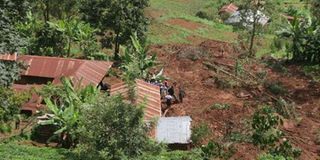Sh15.5bn required to deal with effects of El Niño rains

A landslide in Kahuro Village in Murang'a County on November 3, 2009. The government requires about Sh15.5 billion to deal with the expected effects of the El Niño rains. FILE PHOTO | JOSEPH KANYI | NATION MEDIA GROUP
What you need to know:
The government had set aside Sh5 billion for emergencies in addition to allocating each county government Sh20 million.
Mr Ruto said the budget should be sourced from within ministries to meet the shortfall.
- The United Nations Children’s Fund, the World Health Organisation and mobile provider Safaricom have also expressed interest in helping the government mitigate the problem.
The government requires about Sh15.5 billion to deal with the expected effects of the El Niño rains.
An intergovernmental technical committee established to study and recommend how to deal with the disaster told a Cabinet sub-committee, chaired by Deputy President William Ruto, that the government required an additional Sh10.5 billion to cushion it from any disaster from the rains.
The government had set aside Sh5 billion for emergencies in addition to allocating each county government Sh20 million.
The funds are expected to go into buying food, medicine, tents, transport, relocating affected people and repairing roads and schools in the event of any disaster.
Mr Ruto said the budget should be sourced from within ministries to meet the shortfall.
The Deputy President also said the task force on El Niño should use structures previously set up to deal with disasters to save costs.
“Let us use the structures that are already in existence so that we can save costs. Those structures and facilities are there,” Mr Ruto said during the meeting at his official residence in Karen, Nairobi.
The meeting was attended by Cabinet secretaries Eugene Wamalwa (Water) and Judy Wakhungu (Environment), principal secretaries David Lesiyampe and Mwanamaka Mabruki and other government and county officials.
The meeting resolved that government officers should not factor any allowances for themselves while performing the emergency functions.
WARNED STAFF
County governments have already warned their staff that they should not expect any allowances above their salaries while working during the anticipated disruptions.
Education ministry officials said they were prepared to airlift national examinations in the event roads were rendered impassable.
The United Nations Children’s Fund, the World Health Organisation and mobile provider Safaricom have also expressed interest in helping the government mitigate the problem.
The committee said it is important to immediately mobilise resources to acquire the required materials.
Mr Ruto said: “All sectors need to be fully involved in the preparations to protect lives and property ahead of the expected rains. Awareness creation needs to be intensified among communities.”
The technical team, under the Interior ministry, was formed two weeks ago to work out a coherent plan with measures to be undertaken in specific counties to lessen the adverse effects of the anticipated floods.
According to the El Niño contingency strategic plan for 2014-2018, 1.5 million people could be in need of direct assistance as a result of the floods.
Out of these, 500,000 are expected to be refugees, who will be addressed by the UNHCR, while one million are people in various locations who will form the target of the strategic plan.
AFFECTED AREAS
The plan states that the areas likely to be affected most by El Niño are in northern Kenya (Mandera, Wajir, Marsabit and Garissa), the southeastern parts of the country (Kitui, Makueni, Machakos) and areas along the coast (Lamu, Kilifi, Kwale, Tana River and Taita-Taveta).
Others are the Kano plains, Budalang’i and the Tana delta.
The risk of landslides is expected in areas with steep slopes in central Kenya (Murang’a, Nyeri, and Meru) and along the Rift Valley escarpment.




